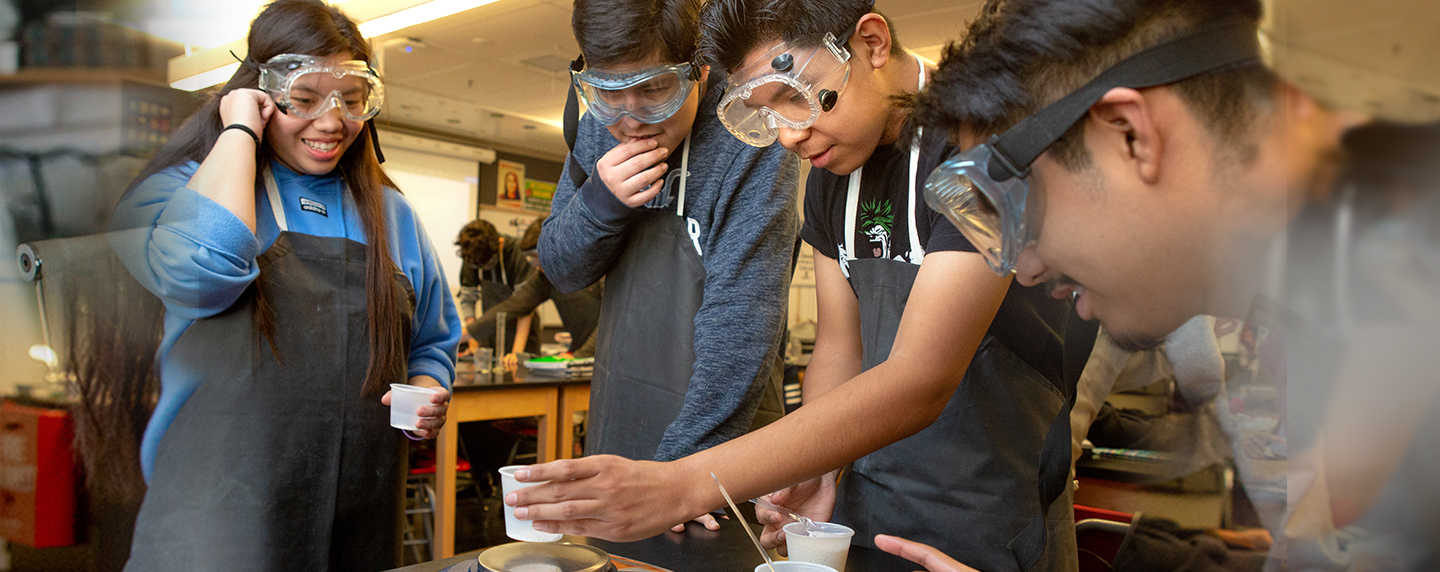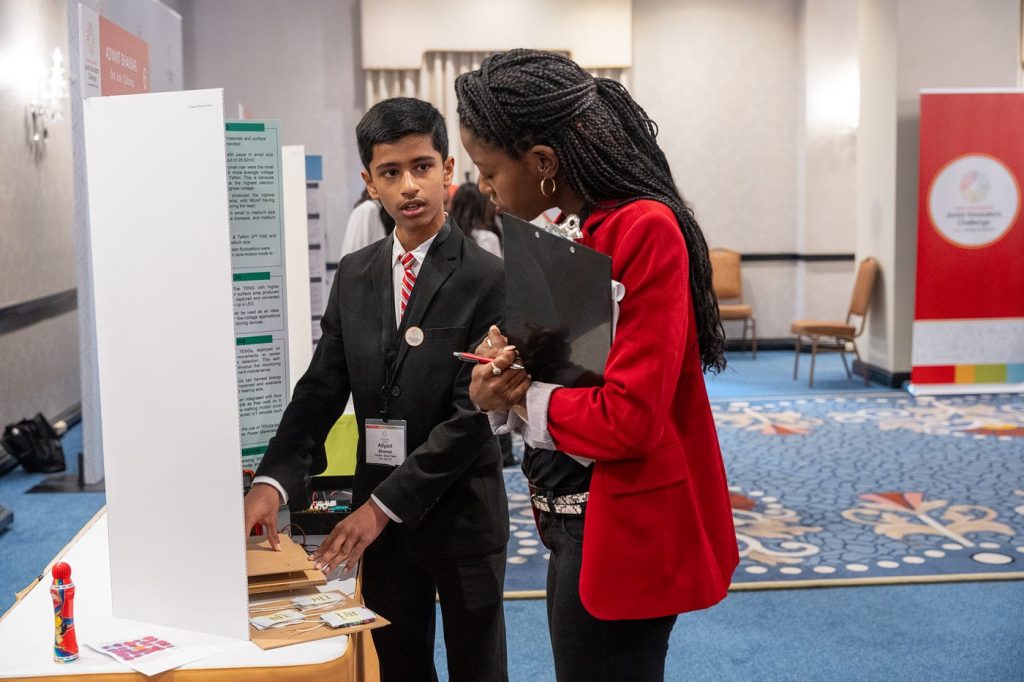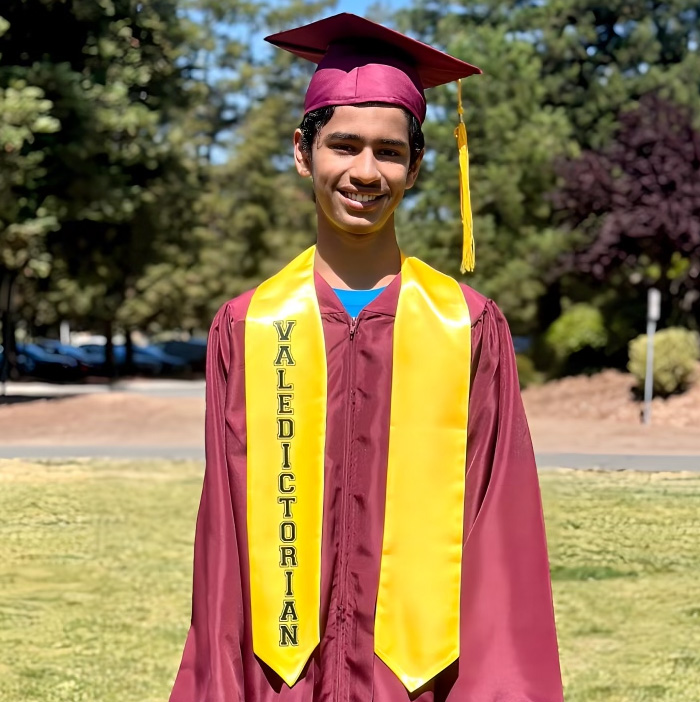
Stories of Impact
Back to In Action / Adyant Bhavsar, Student
Adyant Bhavsar
Seventh grader, Challenger School - Strawberry Park, San Jose, CA
Growing up in California, Adyant became well aware of the impact of wildfires and the devastation they can cause. He wondered what could happen if wildfire monitoring devices ran out of power and was inspired to create a renewable energy source as a solution.
California has hundreds of cameras and sensors that monitor wildfires and other disasters. “This got me thinking,” he says, “that to increase the reliability, these devices would need a sustainable energy supply that does not need frequent recharging or replacing.”
He decided to follow his curiosity and began researching renewable energy sources. When he first read about triboelectricity and electrostatic induction, he thought he could combine the two and build a reliable power source. Thus his idea of building a triboelectric nanogenerator (TENG) was formed. Triboelectric nanogenerators are made with two thin, touching objects. When these objects are separated, or when they slide against each other, electrons transfer between them and cause an electric charge.
To build his own triboelectric nanogenerator, Adyant sandwiched together two wooden planks separated by springs. Each plank held layers of different options of material pairings connected to electrodes. Those material pairings included glass with Teflon, Kapton with human hair, wool with PVC, and paper with cotton. He found that Kapton, a film used in electronics, paired with human hair produced the most electricity, and increasing the surface area increased the electrical output.
In October, Adyant won the 2023 Lemelson Award for Invention as part of Society for Science’s Thermo Fisher Scientific Junior Innovators Challenge. Encouraged by his success, Adyant continued his research on TENGs and entered his regional 2023-24 science fair, where he received both a top prize and a cash prize from the Institute of Electrical and Electronics Engineers (IEEE). More recently, Adyant was selected as his school’s Class of 2024 Valedictorian. In the future, Adyant hopes to work as an environmental engineer and contribute his skills towards a global transition to eco-friendly energy sources.

Adyant at the Thermo Fisher Scientific Junior Innovators Challenge Finals event
Most inventions don’t always go correctly, but it’s important to see what went wrong and learn from that mistake.
How did you decide to invent around the issue of wildfires?
Wildfires are becoming common nowadays, especially with climate change, and a lot of days when you go outside, there’s smoke in the air. Last summer, we got an alert to be ready to evacuate from a wildfire that was close to our neighborhood. The whole experience got me thinking about how we could advance early monitoring for wildfires.
How did you settle on exploring triboelectric nanogenerators as a sustainable energy source for wildfire detectors?
The area of renewable energy is something that I continuously follow, and the professor who pioneered triboelectric nanogenerators, Professor Zhong Lin Wang, has been really influential to me. It’s a new concept, and that’s why I picked it for my project because I think that the data that I found in the correlation between certain materials and their properties could be useful to scientists if they’re looking towards finding that perfect pairing to optimize these generators.

What were your failures and successes like throughout the invention process?
So my project did not go right the first time. Most inventions don’t always go correctly, but it’s important to see what went wrong and learn from that mistake. For me, that feeling of success was when I was able to prove my concept and actually light up an LED using electricity that I generated from my generator. It took a while and there were a lot of errors in building the generator, building a circuit, and connecting the two. But when that lit up, that was such an amazing moment for me because it showed that my invention could actually make an impact.
What impact do you hope your invention makes in the world?
Studies by NASA and other major organizations suggest that TENGs could power essential equipment in the near future, but only if they can be advanced and optimized to a point where they are sustainable and preferable over other energy sources. I hope to work towards introducing TENGs to the market as a low-cost, reliable power source for disaster detection, and ultimately help optimize the output of TENGs to a point where they could replace most energy sources in our world.

Who have your mentors been?
I’ve been really fortunate to have a lot of great people in my life that have helped either spark my interest in STEM or have supported me throughout this project. My science teachers Ms. Chen and Ms. Rayaprolu, both of them have been emphasizing for us to look at problems in the world through a scientific lens. And then my principal Ms. Reinman, she was very supportive of all my endeavors. And my parents of course have helped me a lot because both of them work in the technology field, and they helped foster my interest in STEM since I was very young, and I think that’s played a significant part in who I am today.
If you’re determined to make something a reality, then no matter what hurdles come your way, you’ll be able to do it.
What is your advice to other young inventors?
I think that believing in yourself is a very important skill for an inventor, because when you invent something, there’s going to be a lot of challenges. Additionally, you need passion — because if you’re determined to make something a reality, then no matter what hurdles come your way, you’ll be able to do it. Just remember that you’re the next generation of scientists and brilliant engineers. You are the ones who will be able to work together and help solve the problems of today, and create solutions for them to help humanity in the future.

